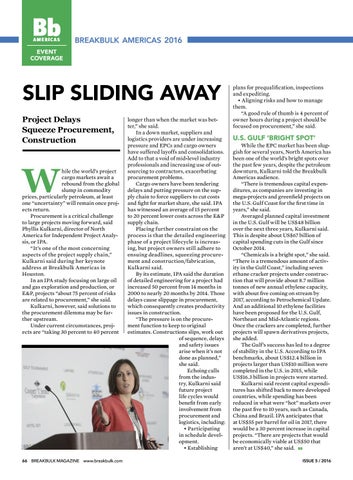breakbulk americas 2016 EVENT COVERAGE
SLIP SLIDING AWAY Project Delays Squeeze Procurement, Construction
W
hile the world’s project cargo markets await a rebound from the global slump in commodity prices, particularly petroleum, at least one “uncertainty” will remain once projects return. Procurement is a critical challenge to large projects moving forward, said Phyllis Kulkarni, director of North America for Independent Project Analysis, or IPA. “It’s one of the most concerning aspects of the project supply chain,” Kulkarni said during her keynote address at Breakbulk Americas in Houston. In an IPA study focusing on large oil and gas exploration and production, or E&P, projects “about 75 percent of risks are related to procurement,” she said. Kulkarni, however, said solutions to the procurement dilemma may be farther upstream. Under current circumstances, projects are “taking 30 percent to 40 percent
66 BREAKBULK MAGAZINE www.breakbulk.com
longer than when the market was better,” she said. In a down market, suppliers and logistics providers are under increasing pressure and EPCs and cargo owners have suffered layoffs and consolidations. Add to that a void of mid-level industry professionals and increasing use of outsourcing to contractors, exacerbating procurement problems. Cargo owners have been tendering delays and putting pressure on the supply chain to force suppliers to cut costs and fight for market share, she said. IPA has witnessed an average of 15 percent to 20 percent lower costs across the E&P supply chain. Placing further constraint on the process is that the detailed engineering phase of a project lifecycle is increasing, but project owners still adhere to ensuing deadlines, squeezing procurement and construction/fabrication, Kulkarni said. By its estimate, IPA said the duration of detailed engineering for a project had increased 50 percent from 14 months in 2000 to nearly 20 months by 2014. Those delays cause slippage in procurement, which consequently creates productivity issues in construction. “The pressure is on the procurement function to keep to original estimates. Constructions slips, work out of sequence, delays and safety issues arise when it’s not done as planned,” she said. Echoing calls from the industry, Kulkarni said future project life cycles would benefit from early involvement from procurement and logistics, including: • Participating in schedule development. • Establishing
plans for prequalification, inspections and expediting. • Aligning risks and how to manage them. “A good rule of thumb is 4 percent of owner hours during a project should be focused on procurement,” she said.
U.S. GULF ‘BRIGHT SPOT’
While the EPC market has been sluggish for several years, North America has been one of the world’s bright spots over the past few years, despite the petroleum downturn, Kulkarni told the Breakbulk Americas audience. “There is tremendous capital expenditures, as companies are investing in mega-projects and greenfield projects on the U.S. Gulf Coast for the first time in years,” she said. Averaged planned capital investment in the U.S. Gulf will be US$48 billion over the next three years, Kulkarni said. This is despite about US$67 billion of capital spending cuts in the Gulf since October 2014. “Chemicals is a bright spot,” she said. “There is a tremendous amount of activity in the Gulf Coast,” including seven ethane cracker projects under construction that will provide about 8.7 million tonnes of new annual ethylene capacity, with about five coming on stream by 2017, according to Petrochemical Update. And an additional 10 ethylene facilities have been proposed for the U.S. Gulf, Northeast and Mid-Atlantic regions. Once the crackers are completed, further projects will spawn derivatives projects, she added. The Gulf’s success has led to a degree of stability in the U.S. According to IPA benchmarks, about US$12.4 billion in projects larger than US$10 million were completed in the U.S. in 2015, while US$16.3 billion in projects were started. Kulkarni said recent capital expenditures has shifted back to more developed countries, while spending has been reduced in what were “hot” markets over the past five to 10 years, such as Canada, China and Brazil. IPA anticipates that at US$55 per barrel for oil in 2017, there would be a 30 percent increase in capital projects. “There are projects that would be economically viable at US$50 that aren’t at US$40,” she said. BB ISSUE 5 / 2016
